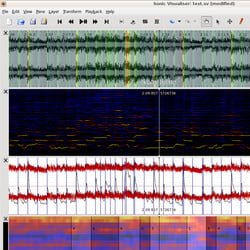

It was important that the Scale Navigator should actually play these chords aloud, and so I used Tone.js to design the synthesizer patch that the user hears when interacting with the interface in the browser - the button in the lower right corner of the interface turns this sound on and off.
Add chord diagram to sonic visualiser generator#
At 0%, the chord generator picks at random from the list of chord candidates regardless of their ranking.įigure 4: Scale Navigator Documentation - YouTube Playlist A slider in the bottom left corner of the screen dictates which candidates get selected: when the slider is all the way to the right at 100%, only the highest ranked chords are chosen. Chords are given a higher fitness score if the next chord has many notes in common with the current chord, or if the next chord has many notes that are stepwise to the notes of the current chord. Nathan Ho created a voice-leading algorithm to ranks this list of candidates according to a fitness function describing the smoothness of voice leading from current chord to next chord. The user can select allowable root movements using the checkboxes in the bottom left corner of the interface.īoyd's algorithm leaves us with a list of allowable next-chord candidates. My colleague Nathan Ho helped me to implement Boyd's algorithm for chord choice based on root movement (Figure 3):įigure 3: Instructions for chord choice based on root movement from Jazz Chord Progressions by Bill Boydīoyd did not give instructions for the case of root movement by tritone, and so the authors allow for selection of a chord in any position in this case.

Part of Boyd's taxonomy of jazz chords includes a Position designation for each chord, of which there are two: the third of the chord is the bottom note in the right hand in Position 1, and the seventh of the chord is the bottom of the right hand in Position 2. This enables pivot chord modulations to distant parts of the graph. Included in this chord display is the option to 'jump' in the network to the selected chord's scalar supersets: other, possibly non-adjacent scales that also contain the pitches of the chord. ♭ 5), added chord-tones, and alterations (e.g. 7), whether or not the fifth is altered (e.g. Depending on the chord, this name may also include the number of an interval (e.g. This selected chord is displayed in a text box in the upper right: root note followed by chord quality.


The chord generated will be a subset of the scale clicked. To generate a new chord, the user clicks on the currently selected scale, one of its adjacent scale neighbors, or one of a list of “scalar supersets” found in the upper right of the interface. The Scale Navigator’s chord generator draws from a lexicon of jazz chord voicings catalogued in Bill Boyd’s Jazz Chord Progressions. While the scale network accounts for the relationship among scales, I wanted the Scale Navigator to also include a way of dealing with chords, so I added a chordal element to the interface. I decided to keep synesthesia in my mind as a guiding design principle while working on the Scale Navigator, determining that the scale's class (whether it be Diatonic, Acoustic, Harmonic Major, Harmonic Minor, Octatonic, Heptatonic or Whole Tone) should govern the shape of the scale node, and the scale's root should dictate the scale node's color. A VexFlow display in the upper left corner shows the notes of the selected scale on a treble staff.Īs a multimedia artist, I am interested in synesthesia and the idea that sound, color, shape, and direction can have meaningful and persistent relationships among one another. Clicking on an adjacent scale selects a new scale. The selected scale is in the center, radially surrounded by adjacent neighbor scales. The basics of the interface are as follows: each scale in the Scale Navigator is represented by a clickable polygonal-shaped node. I was excited about the idea of creating a graphical interface that could allow users to interact directly with the scale network to explore Debussian harmony, and so the Scale Navigator (Figure 2) was born. In the summer of 2018, I came across Scale Networks and Debussy, a paper by Dmitri Tymoczko that describes Claude Debussy's harmonic language as as a crystalline lattice of interlocking scales, or "scale network" (Figure 1).


 0 kommentar(er)
0 kommentar(er)
